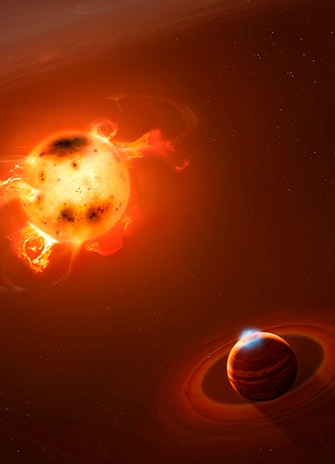The discovery of a giant planet known as a hot Jupiter orbiting an infant sun represents a major step forward in understanding how planetary systems form and evolve, says an international team of astronomers including some from York University.
Hot Jupiters have puzzled astronomers for the last 20 years. How did these giant planets get into orbits 100 times closer to their host stars than our own Jupiter is to the Sun? The paper, published today in the journal Nature shows it’s possible for these hot Jupiters to form early in a star’s life, something that has long been debated. The infant sun where this new hot Jupiter was found is only two million years old – the stellar equivalent of a week-old human baby.
“Our discovery reveals that a giant planet can not only form quickly, but also end up extremely close to its sun soon after the star itself is born,” says co-author Elodie Hébrard, a postdoctoral fellow in Professor Ray Jayawardhana’s research group at York University. “What’s more, the presence of a close-in giant planet so early in a star’s life is likely to have a profound influence on smaller, terrestrial planets that might form in its vicinity.”

In Earth’s solar system, small rocky planets are found near the Sun, whereas gas giants like Jupiter and Saturn orbit much further out. A 1995 discovery of a giant planet close to its host star took the field by surprise as theoretical work indicates that such planets can only form in the cold and icy outer regions of the protoplanetary disc, where the central star and surrounding planets are born. Some migrate inwards without falling into their host star and become what’s known as hot Jupiters.
“It demonstrates for the first time that such bodies can be generated at very early stages of planetary formation, and likely play a central role in shaping the overall architecture of planetary systems,” outlines Jean-François Donati, National Center for Scientific Research astronomer at the Research Institute in Astrophysics and Planetology (IRAP)/Observatory Midi-Pyrénées (OMP) 2 and lead author of this new publication.
Among the known hot Jupiters, some feature strongly-tilted or even upside-down orbits, suggesting they were knocked into close orbits by interactions with other planets or neighboring stars. Others orbit above the host star’s equator, hinting at a more gentle formation process in the form of an inward drift through the disc.
“The young hot Jupiter we just detected comes as the first evidence that early disc migration is also happening,” said Hébrard.
The team monitored the two million-year-old infant star V830 Tau located in the Taurus stellar nursery 430 light-years away from Earth. Over the nealry seven weeks of the campaign, a regular 4.9-day “wobble” in the velocity of the host star revealed a giant planet almost as massive as Jupiter orbiting its host star at a distance of only one 20th that from the Sun to the Earth.
For this discovery, the team used the twin spectropolarimeters ESPaDOnS and Narval, mounted at the 3.6m Canada France Hawaii Télescope (CFHT) on Maunakea and 2m Téléscope Bernard Lyot (TBL) atop Pic du Midi in the French Pyrénées, respectively.
“SPIRou and SPIP, the twin new-generation instruments built for CFHT and TBL by our team and scheduled for first light in 2017 and 2019 respectively, will offer vastly superior performances for such programs, and will soon allow us to explore the formation of new worlds with unprecedented sensitivity,” says Louise Yu, another co-author of the study and PhD student at the IRAP/OMP who is at York University for the summer.


